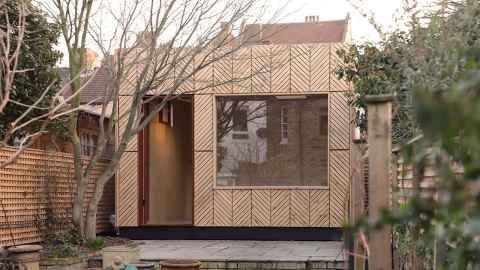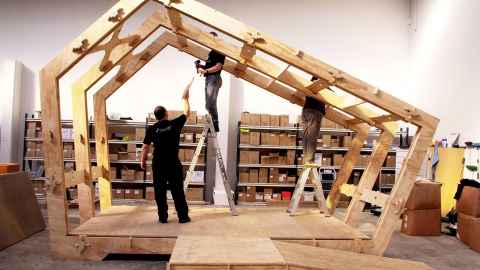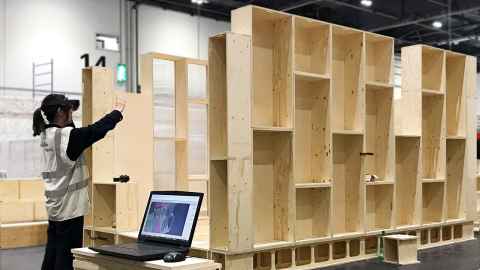The potential of self-assemble well-designed prefab housing
20 March 2023
Opinion: Housing supply has never been more of a problem in New Zealand, and only set to worsen as the climate heats. Diane Brand and Minh Nguyen make the case for investing in well-designed prefabricated housing.

New Zealand has been facing a crisis of housing supply for some years now, and the recent flooding of many areas of the country has served to bring this urgent need into sharp focus. We could make our collective lives easier and safer by investing in well-designed prefabricated houses, designed so they can be assembled by homeowners without complex construction technologies.
The housing issues we are facing are multiple. In certain landscapes a managed retreat from the impacts of climate change is inevitable and should not be delayed; coastal areas, flood plains and unstable topographies are among the most obvious areas needing urgent attention.
The managed retreat scenarios, ecological management and revised land use distributions need immediate attention from the country’s planning authorities at national and local levels, backed by rigorous scientific research and robust legislation to speed up slow implementation processes.
Alongside this work infrastructure redesign by the engineering profession is a critical baseline for further development. It’s apparent that many homes impacted by climate disasters are those in low-income areas where cheap housing has been developed on cheap land by an unholy alliance of developers and councils pursuing profits and rating bases.
We have experience of the Christchurch post-earthquake disaster management to draw on. New Zealand-built environment professionals are skilled in designing healthy, comfortable, affordable, and sustainable housing. There are both well-established and start-up companies producing well-designed environmentally sustainable prefabricated buildings for small segments of the construction market (such as Makers of Architecture, Space Craft, TLC Modular, Xframe and Flexi.house to name a few). We also have many capable researchers at the nation’s universities investigating the design flexibility and economic feasibility of this form of building.

We have the design skills, and we understand the new technologies. What we don’t have is the labour force, the industrial investment or production capacity to produce this product quickly and in volume.
In the 183-year post-colonisation period New Zealand has flirted with prefabrication technologies many times, often inspired by Northern European post-war models of supply. Māori traditions of seasonal settlement indicate an even deeper tradition of portable/relocatable shelters. State housing provision via prefabricated componentry was driven for decades out of the Frankton railway housing workshops in Hamilton, making housing for state workers on infrastructure projects in the mid-20th century.
The solution is to mass produce prefabricated housing componentry which can be easily assembled by a homeowner without using extensive plant or complex construction technologies. The design is crucial, but this country has a good supply of talented design experts in architecture, engineering, landscape architecture and design consultancies. We can learn from existing easily built systems such as the U-Build from the UK or Wikkelhouse from the Netherlands and modify these to New Zealand standards.
A core strategy would be to make all components of the house, from framing to cladding, lightweight and easy to assemble without fully trained builders and construction professionals. Building components manufactured off-site may be flat packed to reduce the cost of transportation.
Being able to produce these components in sufficient volume would demand either large-scale investment and commitment to factory capacity by an investor with deep pockets, or national government agency.
Another alternative is the outsourcing of factory production from another country with an existing and sophisticated infrastructure that could provide prefabricated housing. North America and Europe could too, although it may be prohibitively expensive due to the exchange rate and local labour costs. Asian nations such as China or Vietnam would be well-placed although political concerns could be a constraint.
Given the urgency of the problem the best option in the short term under the aegis of ‘climate emergency’ is to design prefabricated housing components or dwelling units to New Zealand standards that would be made from locally-sourced timber.

These could be factory produced in a low-cost economy such as China and Vietnam, then shipped and built in New Zealand to higher construction and environmental standards than many of the homes they would replace.
In the ideal world suggested here, a wide variety of design character and flexibility would reflect local environmental conditions and building traditions, to avoid the ‘little boxes on the hillside’ phenomenon.
These could be designed as modules which could be added to and subtracted from, are on adjustable earthquake-proof foundations and are relocatable. They should have the capacity for individualisation by homeowners and be able to be agglomerated into larger complexes for extended families or larger residential communities. There exists and excellent model of flexibility in the state houses of the mid-20th Century, homes which while being stigmatised when they were first built now command high prices and are recognised for their quality of materiality, and design variability.
The clock is ticking, and impacted communities are currently under extreme stress. Insurers, the government, and the private sector need to adopt a cooperative and agile approach to fronting and sorting these problems with the utmost urgency. This is an opportunity to finally start resolving the housing affordability crisis in New Zealand. It is unfortunate that it has taken another series of disasters to reach this point.
Professor Diane Brand is an architect and urban designer, Director of Academic Review and former Dean of the Faculty of Creative Arts and Industries, University of Auckland
Dr Minh Nguyen is from the School of Innovation, Design & Technology at Wellington Institute of Technology
This article reflects the opinion of the author and not necessarily the views of Waipapa Taumata Rau University of Auckland.
This article was first published on Newsroom, Smartly designed prefab housing a sensible solution to an urgent problem, 17 March, 2023
Media contact
Margo White I Research communications editor
Mob 021 926 408
Email margo.white@auckland.ac.nz